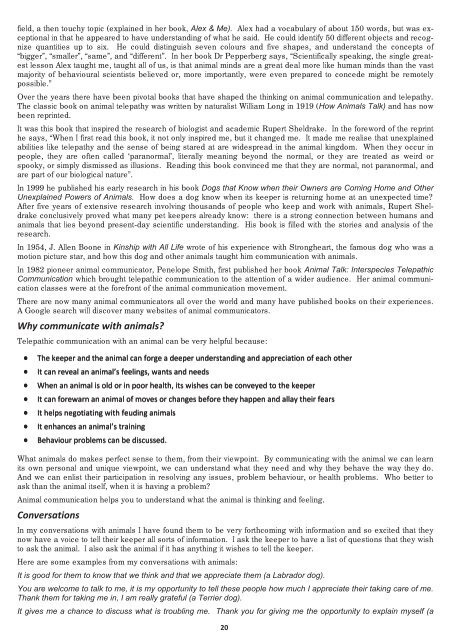September 2011 - Australian Veterinary Association
September 2011 - Australian Veterinary Association
September 2011 - Australian Veterinary Association
Create successful ePaper yourself
Turn your PDF publications into a flip-book with our unique Google optimized e-Paper software.
field, a then touchy topic (explained in her book, Alex & Me). Alex had a vocabulary of about 150 words, but was exceptional<br />
in that he appeared to have understanding of what he said. He could identify 50 different objects and recognize<br />
quantities up to six. He could distinguish seven colours and five shapes, and understand the concepts of<br />
“bigger”, “smaller”, “same”, and “different”. In her book Dr Pepperberg says, “Scientifically speaking, the single greatest<br />
lesson Alex taught me, taught all of us, is that animal minds are a great deal more like human minds than the vast<br />
majority of behavioural scientists believed or, more importantly, were even prepared to concede might be remotely<br />
possible.”<br />
Over the years there have been pivotal books that have shaped the thinking on animal communication and telepathy.<br />
The classic book on animal telepathy was written by naturalist William Long in 1919 (How Animals Talk) and has now<br />
been reprinted.<br />
It was this book that inspired the research of biologist and academic Rupert Sheldrake. In the foreword of the reprint<br />
he says, “When I first read this book, it not only inspired me, but it changed me. It made me realise that unexplained<br />
abilities like telepathy and the sense of being stared at are widespread in the animal kingdom. When they occur in<br />
people, they are often called ‘paranormal’, literally meaning beyond the normal, or they are treated as weird or<br />
spooky, or simply dismissed as illusions. Reading this book convinced me that they are normal, not paranormal, and<br />
are part of our biological nature”.<br />
In 1999 he published his early research in his book Dogs that Know when their Owners are Coming Home and Other<br />
Unexplained Powers of Animals. How does a dog know when its keeper is returning home at an unexpected time?<br />
After five years of extensive research involving thousands of people who keep and work with animals, Rupert Sheldrake<br />
conclusively proved what many pet keepers already know: there is a strong connection between humans and<br />
animals that lies beyond present-day scientific understanding. His book is filled with the stories and analysis of the<br />
research.<br />
In 1954, J. Allen Boone in Kinship with All Life wrote of his experience with Strongheart, the famous dog who was a<br />
motion picture star, and how this dog and other animals taught him communication with animals.<br />
In 1982 pioneer animal communicator, Penelope Smith, first published her book Animal Talk: Interspecies Telepathic<br />
Communication which brought telepathic communication to the attention of a wider audience. Her animal communication<br />
classes were at the forefront of the animal communication movement.<br />
There are now many animal communicators all over the world and many have published books on their experiences.<br />
A Google search will discover many websites of animal communicators.<br />
Why communicate with animals?<br />
Telepathic communication with an animal can be very helpful because:<br />
• The keeper and the animal can forge a deeper understanding and appreciation of each other<br />
• It can reveal an animal’s feelings, wants and needs<br />
• When an animal is old or in poor health, its wishes can be conveyed to the keeper<br />
• It can forewarn an animal of moves or changes before they happen and allay their fears<br />
• It helps negotiating with feuding animals<br />
• It enhances an animal’s training<br />
• Behaviour problems can be discussed.<br />
What animals do makes perfect sense to them, from their viewpoint. By communicating with the animal we can learn<br />
its own personal and unique viewpoint, we can understand what they need and why they behave the way they do.<br />
And we can enlist their participation in resolving any issues, problem behaviour, or health problems. Who better to<br />
ask than the animal itself, when it is having a problem?<br />
Animal communication helps you to understand what the animal is thinking and feeling.<br />
Conversations<br />
In my conversations with animals I have found them to be very forthcoming with information and so excited that they<br />
now have a voice to tell their keeper all sorts of information. I ask the keeper to have a list of questions that they wish<br />
to ask the animal. I also ask the animal if it has anything it wishes to tell the keeper.<br />
Here are some examples from my conversations with animals:<br />
It is good for them to know that we think and that we appreciate them (a Labrador dog).<br />
You are welcome to talk to me, it is my opportunity to tell these people how much I appreciate their taking care of me.<br />
Thank them for taking me in, I am really grateful (a Terrier dog).<br />
It gives me a chance to discuss what is troubling me. Thank you for giving me the opportunity to explain myself (a<br />
20

















